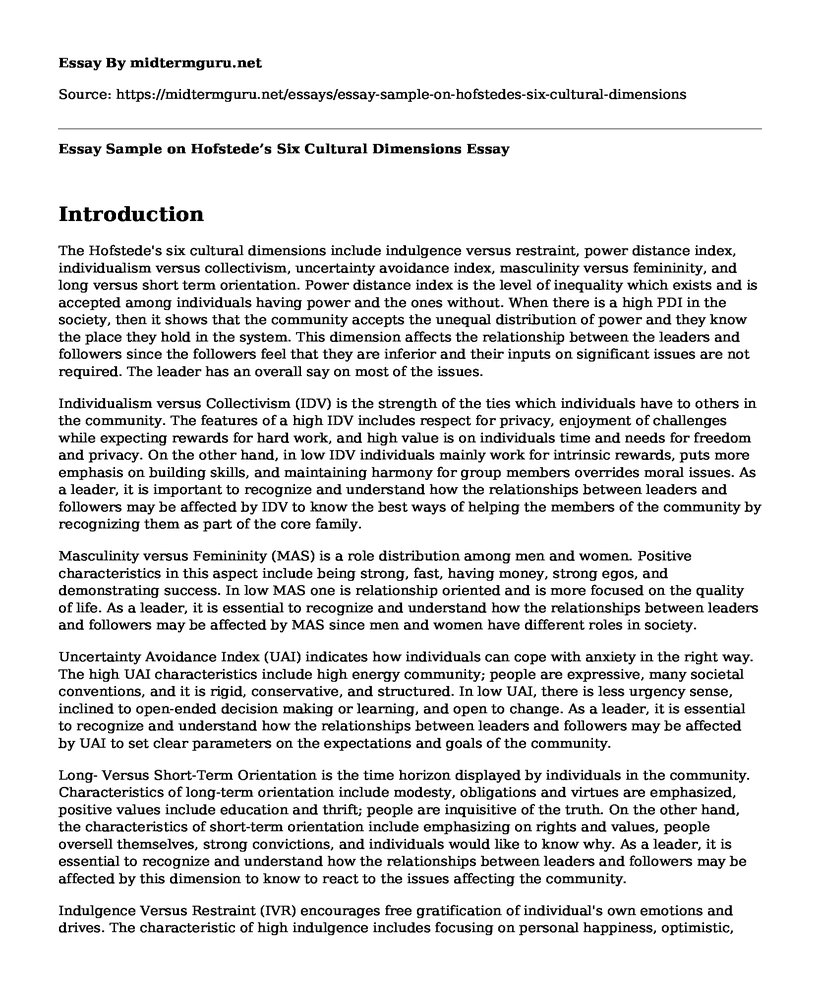Introduction
The Hofstede's six cultural dimensions include indulgence versus restraint, power distance index, individualism versus collectivism, uncertainty avoidance index, masculinity versus femininity, and long versus short term orientation. Power distance index is the level of inequality which exists and is accepted among individuals having power and the ones without. When there is a high PDI in the society, then it shows that the community accepts the unequal distribution of power and they know the place they hold in the system. This dimension affects the relationship between the leaders and followers since the followers feel that they are inferior and their inputs on significant issues are not required. The leader has an overall say on most of the issues.
Individualism versus Collectivism (IDV) is the strength of the ties which individuals have to others in the community. The features of a high IDV includes respect for privacy, enjoyment of challenges while expecting rewards for hard work, and high value is on individuals time and needs for freedom and privacy. On the other hand, in low IDV individuals mainly work for intrinsic rewards, puts more emphasis on building skills, and maintaining harmony for group members overrides moral issues. As a leader, it is important to recognize and understand how the relationships between leaders and followers may be affected by IDV to know the best ways of helping the members of the community by recognizing them as part of the core family.
Masculinity versus Femininity (MAS) is a role distribution among men and women. Positive characteristics in this aspect include being strong, fast, having money, strong egos, and demonstrating success. In low MAS one is relationship oriented and is more focused on the quality of life. As a leader, it is essential to recognize and understand how the relationships between leaders and followers may be affected by MAS since men and women have different roles in society.
Uncertainty Avoidance Index (UAI) indicates how individuals can cope with anxiety in the right way. The high UAI characteristics include high energy community; people are expressive, many societal conventions, and it is rigid, conservative, and structured. In low UAI, there is less urgency sense, inclined to open-ended decision making or learning, and open to change. As a leader, it is essential to recognize and understand how the relationships between leaders and followers may be affected by UAI to set clear parameters on the expectations and goals of the community.
Long- Versus Short-Term Orientation is the time horizon displayed by individuals in the community. Characteristics of long-term orientation include modesty, obligations and virtues are emphasized, positive values include education and thrift; people are inquisitive of the truth. On the other hand, the characteristics of short-term orientation include emphasizing on rights and values, people oversell themselves, strong convictions, and individuals would like to know why. As a leader, it is essential to recognize and understand how the relationships between leaders and followers may be affected by this dimension to know to react to the issues affecting the community.
Indulgence Versus Restraint (IVR) encourages free gratification of individual's own emotions and drives. The characteristic of high indulgence includes focusing on personal happiness, optimistic, and significance of freedom of speech. Consequently, the characteristics of high restraint include pessimistic and more rigid and controlled behavior. As a leader, it is essential to recognize and understand how the relationships between leaders and followers may be affected to include everyone in society by using dialogue or debates in decision making or meetings.
It is the onus of both the leaders and followers to adapt to the strategies for them to be effectively implemented in an organization or a community. For example, if a new culture is brought to an organization and both the employees and the leaders follow it, then it will achieve its intended purpose in the long run.
Cite this page
Essay Sample on Hofstede's Six Cultural Dimensions. (2022, Dec 27). Retrieved from https://midtermguru.com/essays/essay-sample-on-hofstedes-six-cultural-dimensions
If you are the original author of this essay and no longer wish to have it published on the midtermguru.com website, please click below to request its removal:
- Review of the Book Other Peoples Children: Cultural Conflict in the Classroom
- How Diversity Affects Local Feed Yard
- Social and Cultural Differences in Secondary Education - Essay Sample
- Blacking Up Hip Hop: Documentary Analysis Essay
- Maximizing Business Outcomes Through Cultural Diversity - Essay Sample
- Does Multiculturalism Have a Place in Higher Education? - Paper Exapmple
- Police-Community Partnership: Exploring the Impact of Cultural Diversity - Essay Sample







